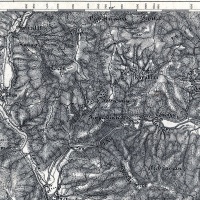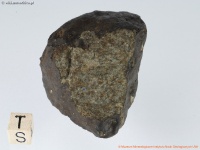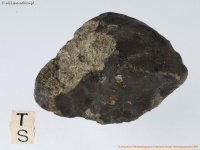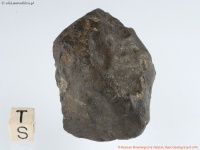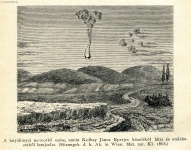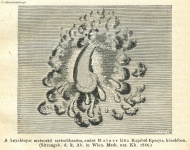(Unless otherwise stated, the copyright of the materials included belong to Jan Woreczko & Wadi.)
Knyahinya
Z Wiki.Meteoritica.pl
| Knyahinya → | |
| 280px
Meteoryty Knyahinya w Muzeum Historii Naturalnej w Berlinie (fot. Wadi & Jan Woreczko)
| |
| Spadek | |
| Lokalizacja | Ukraina (Słowacja) |
| Położenie[1] | 48°54'N, 22°24'E |
| Data | 9 czerwca 1866 r., ~17:00 (4:56 czasu lokalnego) |
| Uwagi | największy europejski pojedynczy okaz meteorytu ~279,8 kg |
| Charakterystyka | |
| Typ | chondryt zwyczajny, L/LL5 |
| Masa | ~500 kg |
| Liczba okazów | ok. 1000 okazów; największy ~279,8 kg |
| Meteoritical Bulletin Database | |
| Synonimy → | |
| w NHM Cat: Csillagfalva, Knahyna, Kniaginia, Knyhyna, Kuyahinga, Nagy-Bereszna; po rosyjsku: Княгиня | |
Spadek 9 czerwca 1866 roku ok. 17:00 na Ukrainie/Węgrzech (L/LL5).
Kulę ognia dostrzeżono w północnych Węgrzech nad miastem Liptovský Mikuláš, która po przeleceniu około 220 km na wschód wybuchła nad miastem Knyahinya tworząc czarne chmury. Następnie pośród hałasu spadł deszcz kamieni. Chmura zszarzała i przemieszczając się na południe została rozproszona przez wiatr. Około 1200 kamieni spadło na obszar 7×4 km w pobliżu miejscowości: Zboj (obecnie Słowacja), Nova Stuzhitsya, Knyahinya i Strychava (obecnie Ukraina), nikt nie został ranny. Węgierska Akademia Nauk skierowała w ten rejon komisję. Największy znaleziony okaz to około 279,8 kg (obecnie znajduje w Muzeum Historii Naturalnej w Wiedniu), drugi co do wielkości (46 kg) został kupiony za 750 florenów dla Węgierskiego Muzeum Narodowego (zniszczonego w 1956 roku przez pożar).
Źródła
Wg B.A.A.S. (1868)
(…) Nearly simultaneously with the appearance of a small bluish cloud in the air over Sztricsava, near Knyahinya, there was heard at that place, and for many miles round, a sharp report, like that of a six-pounder cannon, followed for ten minutes by a rumbling sound like that of water boiling, the rumbling of a cart on a pavement, or of stones striking together. Three of four minutes after the first report stones were seen to fall at various places over an extent of area measuring from N.N.E. to S.S.W. about 9 miles in length, and about 3½ miles in breadth from W.N.W to E.S.E. The stones when picked up were lukewarm, as if shone upon by the sun†, or even as warm as if taken freshly from an oven. One, of the size of a plum, which fell upon a linen cloth, did not singe it. The smaller stones did not penetrate the earth more than a few inches, or lay upon surface. One of moderate size, which fell through a tree at the door of the inn at Knyahinya, broken from it a branch half an inch in thickness; and ten such branches were broken by a larger stone, in its fall through an apple-tree, beneath which it was found. Many other stones were seen to fall. That which weighed 73½ lbs. (Austrian) penetrated the firm sandstone-earth of the district to a depth of 2 feet. About 100 paces from it, three weeks after the occurrence, was found a hole 4 feet wide and 4½ feet deep, round which the earth had been scattered to a distance of 30 yards. On sounding the hole a firm stone was discovered at a depth of 11 feet below the surface. The aërolite was exhumed. It was found to be broken across, and, with the remaining pieces discovered in the same hole, weighed about 300 kilogrammes (660 lbs. English). The direction of penetration was from N. 30° E., altitude 63°. Its position, a league N.E. from Knyahinya, occupies the extreme N.N.E. corner of the general area of the fall. Another very large stones is said to have fallen about two miles S.W. from Knyahinya, which could not be discovered. (…)
- __________
- † And not, as stated in Dr. Haidinger's[2] first report, but corrected by later communications, "ice-cold."
Za portalem Meteorites in the Carpatian Basin
History of the fall: A fireball was first noticed in northern Hungary above the town now called Liptovský Mikuláš and flew some 220 km to the east until exploded with thunderous detonation above Knyahinya, producing a black cloud. A shower of stones fell from the cloud with a whizzing noise. Then the black cloud turned to a grey cloud of dust, moving southward and dispersed by the wind. Some 1200 stones fell in a ~7×4 km strewn field in the vicinity of Zboj (now Slovakia), Nova Stuzhitsya, Knyahinya and Strychava (now Ukraine) but nobody was injured. The Hungarian Academy of Sciences sent a commission to visit the scene. The largest recovered specimen (now in the Natural History Museum in Vienna) weighed some 300 kg, the second largest (46 kg) one was bought for 750 florins for the Hungarian National Museum (destroyed by fire in 1956).
Lokalizacja
(K) Kniahynia, (L) Liptovský Mikuláš, (S) Strychava, (S) Stuzhytsia, (Z) Zboj
położenie "krateru" i pamiątkowego obelisku
współrzędne wg innych autorów
* W 2018 roku Google zmieniło zasady działania apletu, mapa może wyświetlać się niepoprawnie (pomaga Ctrl+F5); więcej → Szablon:GEMap-MyWiki
Pamiątkowy obelisk w kraterze (?)
Deszcz meteorytów Knyahinya był bardzo obfity. Biorąc pod uwagę spory obszar oraz trudny teren, jest bardzo prawdopodobne, że do dziś mogą znajdować się tam jeszcze okazy - vide współczesne znaleziska meteorytu Pułtusk z tego samego okresu.
Panuje sporo niejasności o kierunku spadku. Przyjęło się go uważać za spadek niemal pionowy, ale co w takim razie z obserwacją w Liptovským Mikulášie?
Mapy
Galerie
Meteoryt Knyahinya ze zbiorów Muzeum Mineralogicznego Instytutu Nauk Geologicznych UWr (dla Wiki.Meteoritica.pl fot. Antoni Stryjewski)
Knyahinya (MHN Budapeszt).jpg
Gablota z okazami meteorytów Knyahinya w zbiorach Muzeum Historii Naturalnej w Budapeszcie (fot. Wadi & Jan Woreczko) |
Bibliografia
- +von Haidinger Wilhelm Ritter, (1866), Der Meteorsteinfall am 9. Juni 1866 bei Knyahinya nächst Nagy Berezna im Ungher Comitate. (Mit 1 Tafel.[3]) Sitzber. Akad. Wiss. Wien (Sitzungsberichte der Kaiserlichen Akademie der Wissenschaften), vol. LIV, II Abth., 1866, s. 197, 200-205.
- +von Haidinger Wilhelm Ritter, (1866), Der Meteorsteinfall am 9. Juni 1866 bei Knyahinya. Zweiter Bericht. (Mit 3 Tafeln.[4])[5] Sitzber. Akad. Wiss. Wien (Sitzungsberichte der Kaiserlichen Akademie der Wissenschaften), vol. LIV, II Abth., 1866, s. 409, 475-522.
- +B.A.A.S., (1868), Reports on Observations of Luminous Meteors during the year 1867-68.[6] Reports from the British Association for the Advancement of Science (B.A.A.S.), vol. 38, 1868, s. 378. Plik GIF.
- +Meteorite in Hungary of June, 1866; by Joseph Szabo. American Journal of Science and Arts, series 2, vol. 42, 1866, s. 432. Plik GIF.
- +Der Meteorsteinfall am 9 Juni, 1866, bei Knyahinya (zweiter Bericht); von Wilhelm Ritter v. Haidinger. American Journal of Science and Arts, series 2, vol. 44, 1867, s. 131. Plik GIF.
- Török József, (1882a), A Magyar Birodalom meteoritjei (I. rész), Természettudományi Közlöny, XIV (159), 1882, s. 433-442. Plik DjVuŹródło: Wiki.Meteoritica.pl; plik PDF.
- Török József, (1882b), A Magyar Birodalom meteoritjei (II. rész), Természettudományi Közlöny, XIV (160), 1882, s. 497-514. Plik PDF.
- Wülfing Ernst Anton von, (1897), Die Meteoriten in Sammlungen und ihre Literatur. Nebst einem versuch den tauschwert der meteoriten zu bestimmen (Meteorites in Collections and Their Literature. Including An Attempt To Determine The Exchange Value Of Meteorites), Verlag der H. Laupp'schen Buchhandlung, Tübingen 1897.[7][8][9] Plik GIF; plik Internet Archive; plik GoogleBooks. Pozycje bibliograficzne dotyczące meteorytu Knyahinya - s. 182-183.
Przypisy
Zobacz również
Linki zewnętrzne
- Meteoritical Bulletin Database (MBD) - meteoryt Knyahinya
- Encyclopedia of Meteorites (EoM) - meteoryt Knyahinya
- meteorite.narodu.ru - Каталог метеоритов России и стран бывшего СССР
- Wikipedia (DE) - Knyahinya (Meteorit)
- Wikipedia (HU) - Knyahinyai meteorit
- Wikipedia (RU) - Княгиня (метеорит)
- Muzeum Historii Naturalnej w Budapeszcie (Hungarian Natural History Museum, Budapest) - Magyar Természettudományi Múzeum Budapest • Meteorites in the Carpatian Basin
- Muzeum Historii Naturalnej w Wiedniu - Naturhistorisches Museum Wien • kolekcja meteorytów
